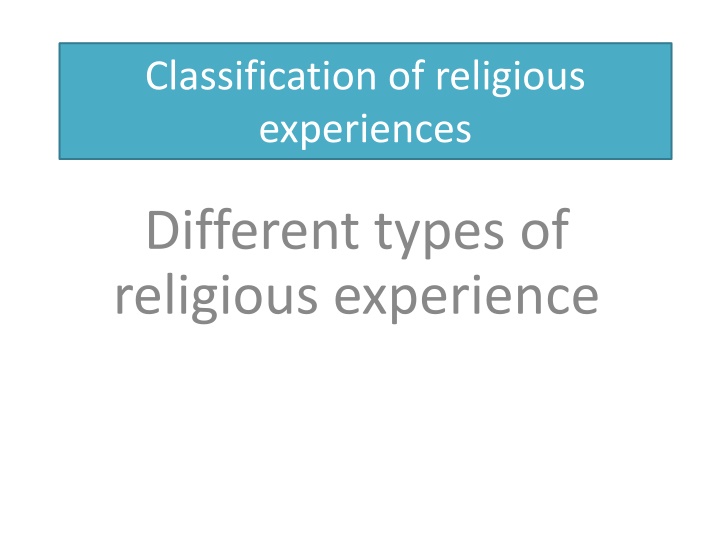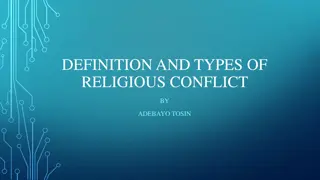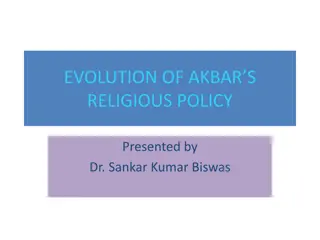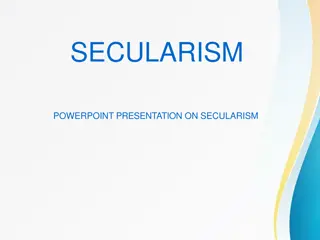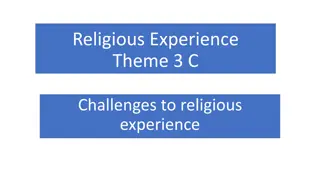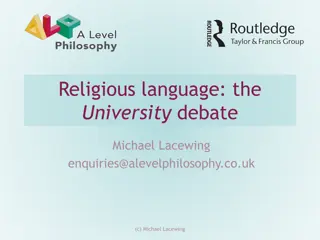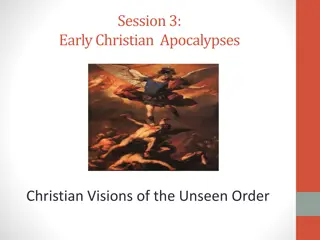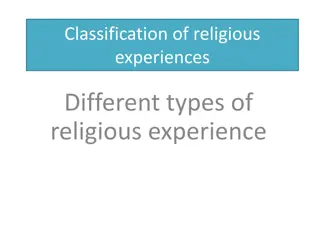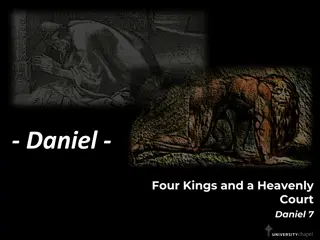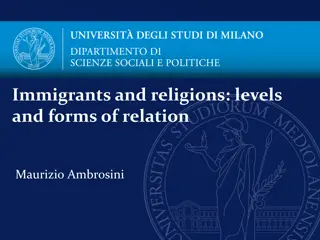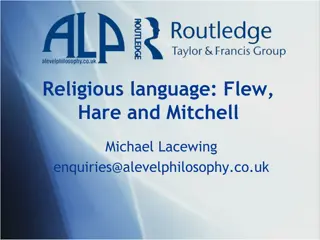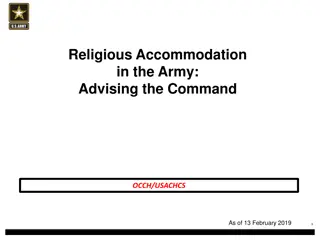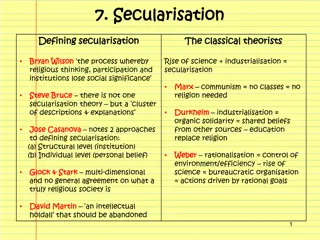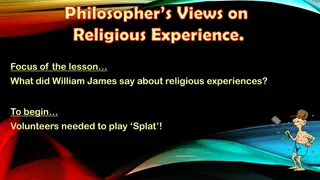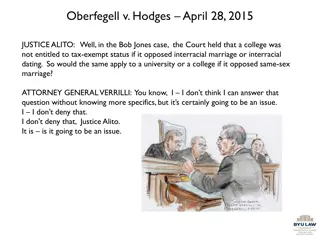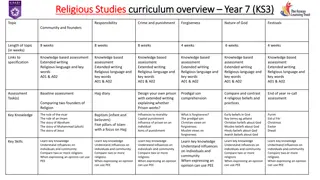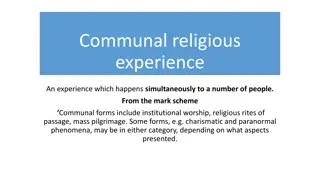Nature of Religious Experiences: Types and Visions Explored
This section delves into different types of religious experiences, including visions of sensory, intellectual, and dreams, as well as examples from historical figures like St. Teresa of Avila and St. Bernadette. Explore the definitions, manifestations, and significance of these profound encounters in various religious traditions.
Uploaded on Feb 18, 2025 | 2 Views
Download Presentation

Please find below an Image/Link to download the presentation.
The content on the website is provided AS IS for your information and personal use only. It may not be sold, licensed, or shared on other websites without obtaining consent from the author.If you encounter any issues during the download, it is possible that the publisher has removed the file from their server.
You are allowed to download the files provided on this website for personal or commercial use, subject to the condition that they are used lawfully. All files are the property of their respective owners.
The content on the website is provided AS IS for your information and personal use only. It may not be sold, licensed, or shared on other websites without obtaining consent from the author.
E N D
Presentation Transcript
Classification of religious experiences Different types of religious experience
This first section is designed to introduce candidates to the nature of religious experience by referring to various forms of religious experience. Each of the four stated forms: visions; conversion; mysticism and prayer should be studied in the light of religious traditions which can exemplify each of these. Centres will find reference to Teresa's types of prayer, as explained in The Interior Castle, useful to refer to. Similarly, centres should refer to Teresa's description of the stages of prayer as explained in the Garden analogy. In each case, (i.e. types and stages) candidates will be expected to be familiar with both of her analogous explanations and be able to give a brief description of each. Centres may focus on one tradition (e.g. Islam) for exemplification of all four forms, although it is equally permissible to draw on examples from several different religious traditions if that is deemed preferable.
The nature of religious experience with particular reference to: D Visions sensory; intellectual; dreams. Conversion individual/communal; sudden/gradual. Mysticism transcendent; ecstatic and unitive. Prayer types and stages of prayer according to Teresa of Avila.
Visions Definitions - sensory; intellectual; dreams. Examples Joan of Ark's vision St Teresa of Avila's vision
Definition: Something seen other than by ordinary sight Usually believed to come from a deity i.e. God, Jesus or the Virgin Mary Conveys a message or revelation of some sort
What do people have visions of? Religious figures- St Teresa of Avila, St Bernadette Places (heaven & hell) Fantastic creatures / figures ~ Ezekiel The future
Different types of vision Sensory/ Corporeal visions- where the object is external and conveys knowledge and understanding to the recipient and is only visible to certain people Dreams/ Imaginative visions- where the image is produced in the persons imagination, the unconscious state where knowledge or understanding is gained through a series of images or a dream- narrative i.e. it is internal Intellectual visions brings knowledge and understanding such as revelation from God Also Group visions- seen by more than one person Individual visions- seen only by one person
Sensory visions Group visions Individual visions Corporeal visions Seen by more than one person. Angel of Mons First World War British soldiers saw a vision of St George and a phantom bowman Seen by only one person E.g. Bernadette next slide Often imaginative or dream based, internal visions e.g. Wise men/Magi warned in a dream not to return to Herod in Matthew s Gospel 2:12 Of a material nature, physical
Content of visions Religious figures-St Teresa of Avila s vision of an angel holding a long spear that seemed to pierce her heart several times and when it was withdrawn it left her completely afire with a great love for God , St Bernadette Places (heaven & hell) Guru Nanak s vision of God s court Fantastic creatures / figuresEzekiel s vision of four living creatures The future John s visions in the book of Revelation that describes the dead being judged.
An example of a famous vision: Lourdes: is one of the most visited places (pilgrimages) in the world, by Catholics
Consolidation Find and read Genesis 28: 10-22 What type of vision?
Conversion Definitions Conversion means to change direction or to turn around . It is a process of change that alters one s view of the world and one s personal place in it. St Paul's conversion Cat Stevens conversion to Islam Scholars to research William James Moojan Momen Lofland and Stark
Types of conversion Can convert from one religion to another Can convert to a religion when previously had no faith - Augustine is an example of a moral conversion, in that his wayward life was challenged when he read the words from Romans, which exhorts the reader to abandon the works of the flesh and be clothed with Christ. Can convert from believing to trusting - John Wesley s vivid experience that enlivened his faith. He wrote: I felt my heart strangely warmed, I felt I did trust Christ, Christ alone, for salvation; and an assurance was given me, that he had taken away my sins
Types of conversion Individual Communal The conversion is of a group of people at the same occasion The first Pentecost in Acts of the Apostles 2:1 21 (New Testament). The conversion is of a single person rather than a group Paul s conversion, when he saw blinding light and heard the voice of Jesus calling him to ministry. His life was changed forever.
PASSIVE The conversion is not deliberately sought but comes upon them unexpectedly. ACTIVE The conversion is deliberately sought, perhaps by going to an evangelistic meeting with the intention of responding to the preacher SUDDEN The conversion takes place suddenly, when a clear decision is made and a particular date can be given for the event. However, there may have been prior sub-conscious development. GRADUAL The conversion takes place over a length of time possibly even years
Mysticism A mystical experience is one in which the subject becomes overwhelmingly aware of the presence of God Mystical experiences have several common features: A sense of union with the divine. A sense of dependence on God. A sense of separateness from God. Time is transcended. Noetic experiences (William James) or a showing (Mother Julian of Norwich) something is clearly revealed to the person receiving the experience. A sense of joy and well-being
Paul Tillich described two stages in a mystical experience: The first is an event or encounter The second is a special understanding of that event as the result of ecstasy, a special way of looking at the event which reveals its religious significance.
The nature of mystical experiences Nature - The experience of oneness with nature. God is everywhere so he can be experienced through the natural world Monistic - The experience of one s own spirit as the Absolute, the identity of Atman and Brahman. Theistic - Union or communion with a personal Lord. In which the mystic looks inwards on her own experience and understands her own oneness with the divine Introvertive - Where the experience of the mystic is like that of the poet, contemplating outward circumstances.
Transcendent; ecstatic and unitive. Ed Miller created a summary of mystical experiences Transcendent: not localisable in space or time, takes the experient beyond the realm of normal everyday experience e.g. other worldly Escatic: filling the soul with bliss and the closest mortal souls can get to the presence of God Unitive: uniting the soul with reality, removal of the separation between the individual and God Plus Ineffable: not expressible in language Noetic: conveying illumination, truth, new knowledge
Mystical experiences Scholars to research Examples James Teasdall Happold Pahnke Stace Zaehner Smart Ottp Hindu Yoga Buddhist meditation Judaism Kabbahal Islam - Sufism
Prayer In a sense all religious experience is about prayer i.e. communion with God.
Types of Prayer Blessing - Ephesians 1:3 Adoration - Psalm 95.6 Petition - Colossians 4:12 Asking forgiveness - Luke 18:13 Intercession - 1 Timothy 2:1 Thanksgiving - 1 Thessalonians 5:18 Praise - Ephesians 3:20
St Teresa of Avila Scholars teachings on prayer St. Teresa of Avila (1515-1582) was a Spanish mystic and Roman Catholic saint. She had several religious experiences during her life, and wrote about the importance of mystic prayer to religious life. Teresa believed that the purpose of life was union with God, which is also the purpose of prayer. Therefore, the purpose of life is union with God through prayer. She wrote of the seven types of prayer in her work, The Interior Castle, and the stages of prayer in the analogy of the garden.
The Interior Castle This work describes the seven mansions or seven dwelling places that each represent a step towards unity with God. It is a guide for spiritual development through service and prayer. Initially, we are introduced to those outside the castle who are described as paralyzed and crippled by sin. This level represents those who are spiritually and morally bound by evil.
The Garden Analogy The analogy is presented in the Autobiography of Teresa of Avila, and gives the metaphor of a garden; with the earth representing the soul and water being the understanding of grace. Teresa stated that a beginner must look on himself as one setting out to make a garden for His Lord s pleasure, on most unfruitful soil which abounds in weeds. His Majesty roots up the weeds and will put in good plants instead.
Four stages 1. First Water (mental prayer) 2. Drawing Water (prayer of quiet) 3. Irrigated Garden (imperfect union) 4. Rain (perfect union)
